The New Hampshire Apartments: Where Bela Bartók Meets Tarzan
Views: 409
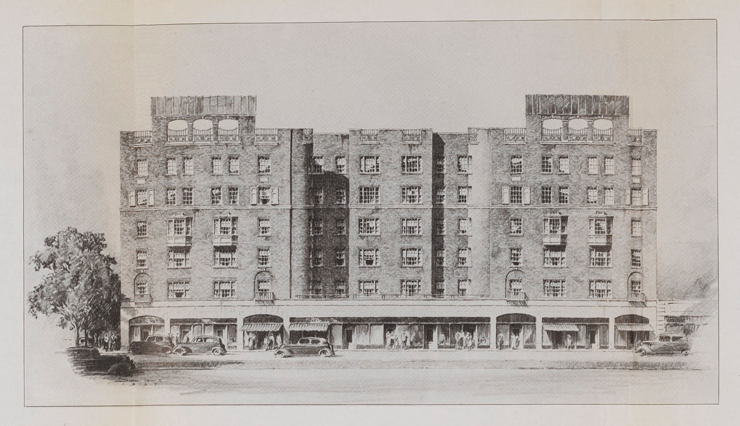
New Hampshire Apartments’ historic facade rendering.
A Forest Hills Residential Gem Echoes Harmonies
By Michael Perlman
Encounter a plaque which reads “New Hampshire Apartments” on a stately pre-war six-story building at 110-31 73rd Road in Forest Hills, and with a bit of research, stories of yesteryear will unfold. Current residents may be unaware that it was once home to legendary Hungarian composer and pianist Béla Bartók (1881 – 1945), as well as Hungarian actor, swimmer, and water polo player Johnny Weissmuller (1904 – 1984), best known as “Tarzan.”
The New Hampshire Apartments was erected in 1937 by Boulevard Construction Corporation, which was also the owner, and designed by award-winning architect Benjamin Braunstein. Immigrating from Constantinople, he would achieve a large number of historic apartment buildings, spanning the Tudor, Georgian Colonial, and Spanish Mission style in neighborhoods including Forest Hills, Rego Park, and Kew Gardens. As for The New Hampshire, the façade uniquely merges the Georgian Colonial and Art Moderne style, characterized by curved exposures with glass block, recessed facades, bay windows, archways, and a former roof garden and sun deck.
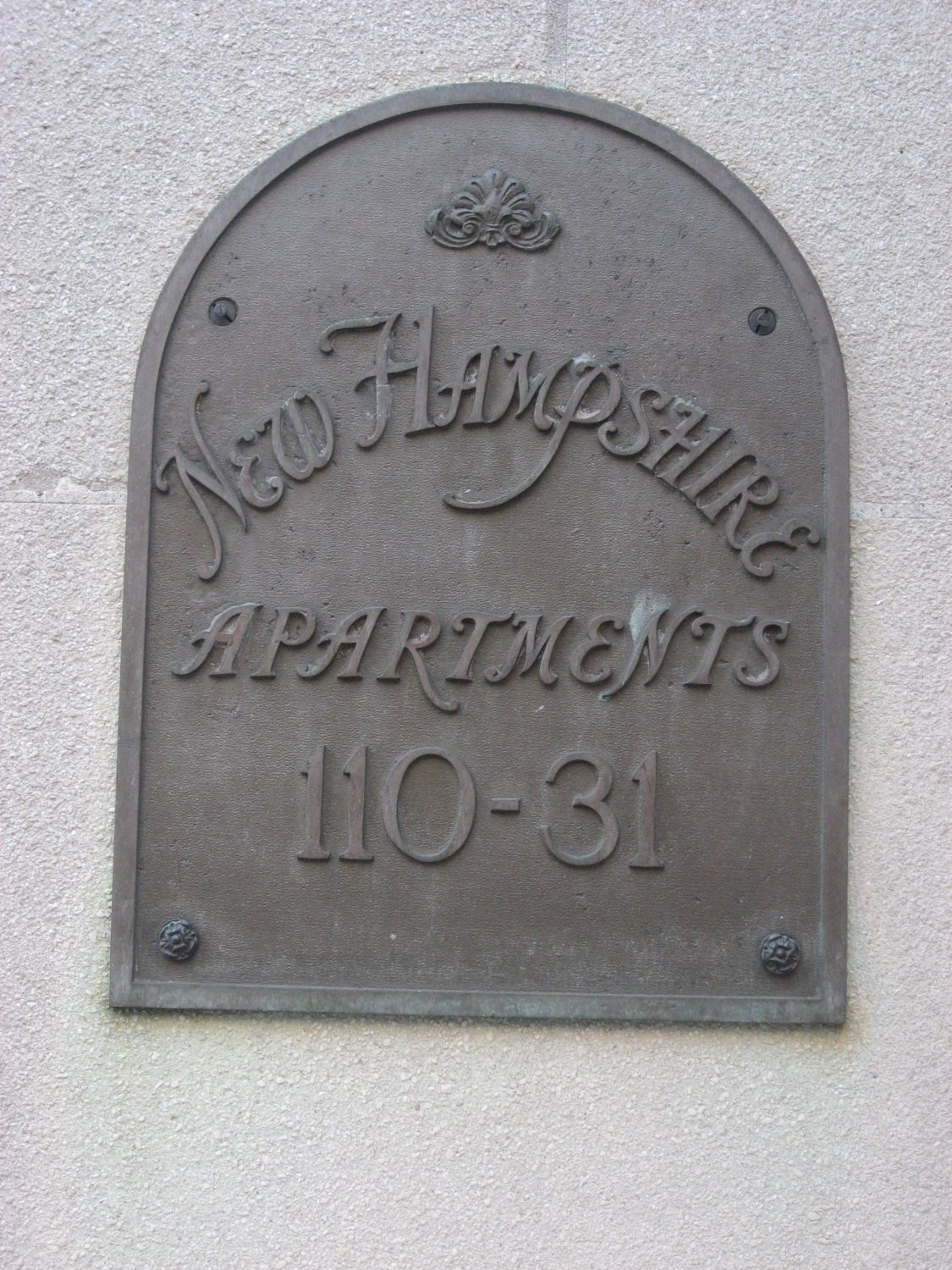
Facade plaque.
Apartments were advertised for their exceptional layouts with spacious foyers, radio outlets, soundproofing, nine rooms, and “appointments of the most modern Park Avenue apartments.” The lobby and hallways were carpeted. The residence’s convenience to small businesses, places of worship, the 1936 IND subway line, parks, the West Side Tennis Club, and the conceived 1939 – 1940 World’s Fair, was a major draw.
Around 1940, Bartók and his wife became Forest Hills residents. As for Peter Sipsas, who recalls its sense of place, he is not surprised that celebrities called this address home. “I can never forget long summer days of hopping the fence separating our building from the next one, The Mayfair House, and playing Stickball with kids from the block, sometimes from noon to night. On July 4th, someone’s dad would barbecue, and we would take our dogs and burgers to the roof, where we could watch the fireworks on the East River. It was a very idyllic childhood.”
Bartók made his American debut with the Philharmonic Orchestra at Carnegie Hall with Rhapsodie Op. 1 in 1927. He was noted for his blend of late Romanticism, Eastern European folk music, and Debussy, and transcribed folk songs into Classical masterpieces. Among his notable compositions are “Two Portraits,” “Dance Suite,” “Two Pictures,” and “Music for Strings,” and “Percussion and Celesta, Sz. 106, BB 114.” Sad themes are apparent in “String Quartet No. 6,” which was his response to World War II. Among his stage works are “Prince Bluebeard’s Castle,” “The Miraculous Mandarin,” and “The Wooden Prince.”
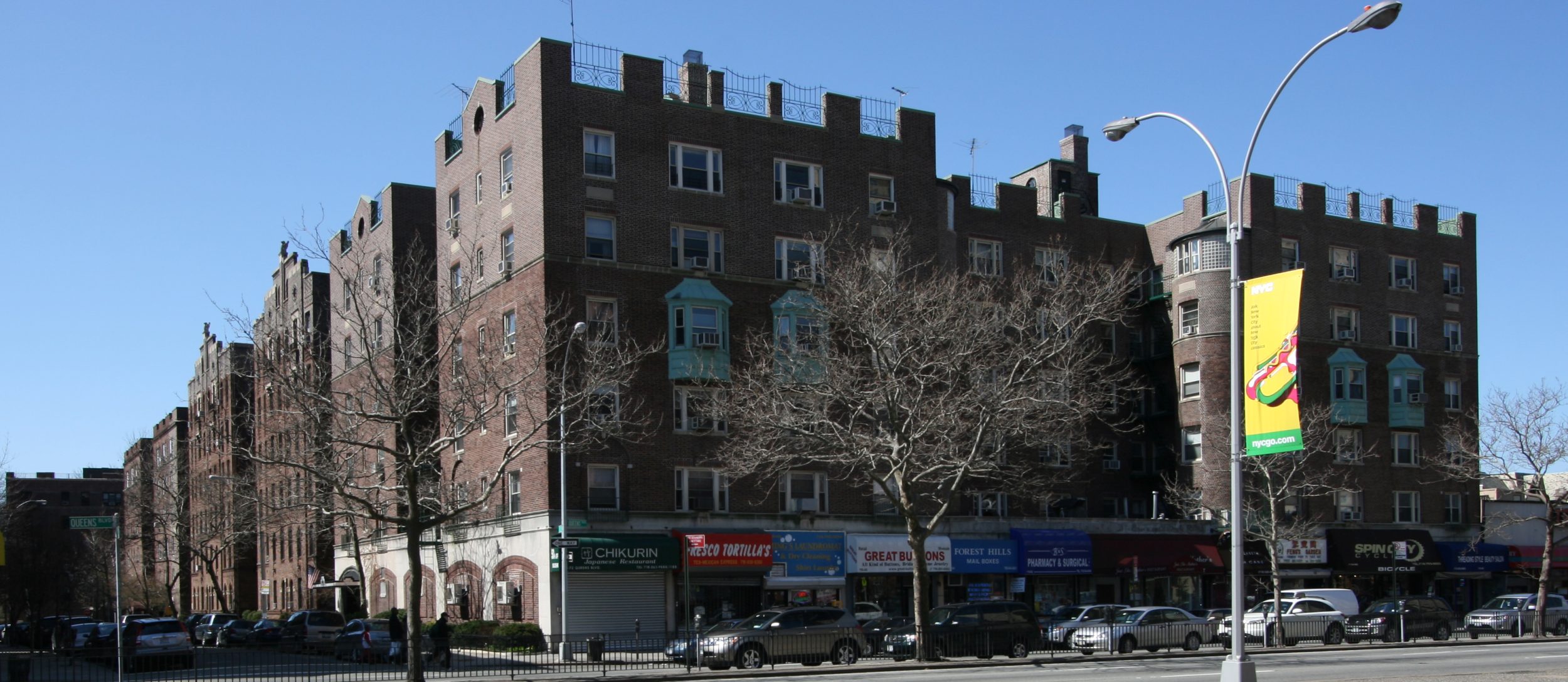
New Hampshire Apartments, 2009.
“I played Bartók’s music when I learned to play the cello in Hungary around age 7,” said Peter Arato, who lived in the New Hampshire Apartments from 1983 to 1985 with his wife. “Our apartment had character, with ten-foot ceilings and interesting molding, and to learn that he also lived in our building is fascinating.”
“It’s amazing that Bartók immigrated to the USA from Hungary and eventually settled in Forest Hills,” said local resident William Gati, a pianist and architect, who praised him as one of the greatest classical twentieth century composers. “He was part of the creative exodus from Europe before WWII that catapulted the American creative and intellectual revolution. Bartók, like my father, studied at the Liszt Academy in Budapest. We shared Forest Hills with a musical genius.” Gati also pointed out how Bartók was among other twentieth century notables, including Charlie Chaplin and Sergei Prokofiev, who came to New York City, with hopes for a better life.
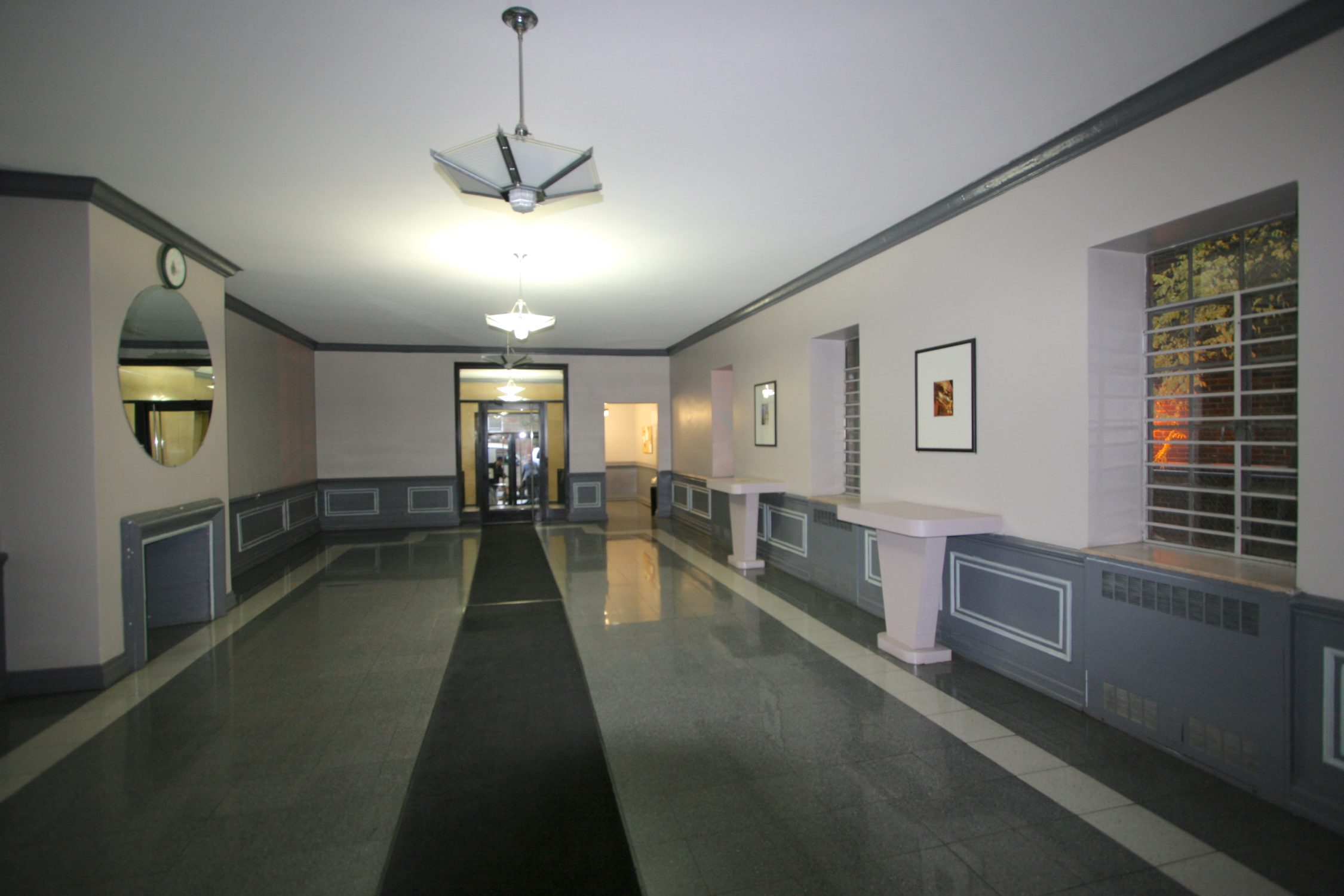
New Hampshire Apartments lobby, where celebrities walked.
At 6 feet 3 inches and 190 pounds, Weissmuller won five Olympic gold medals in 1924 and 1928, 52 national and 67 world titles, and held freestyle records from 100 yards to the half-mile. He was known for holding one of the best competitive swimming records of the twentieth century. Associated Press recognized him as “Greatest Swimmer of The Half Century” in 1950. He popularized the American crawl stroke position, as his chest appeared high out of the water.
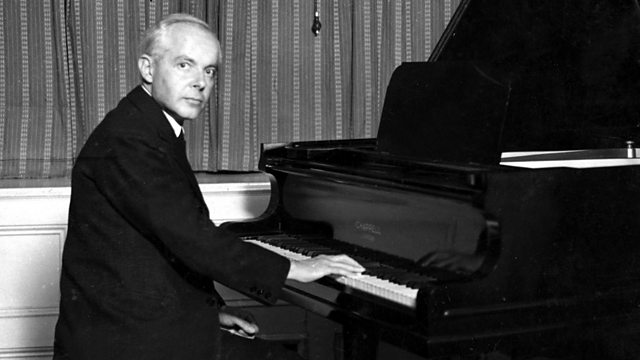
Béla Bartók at the piano.
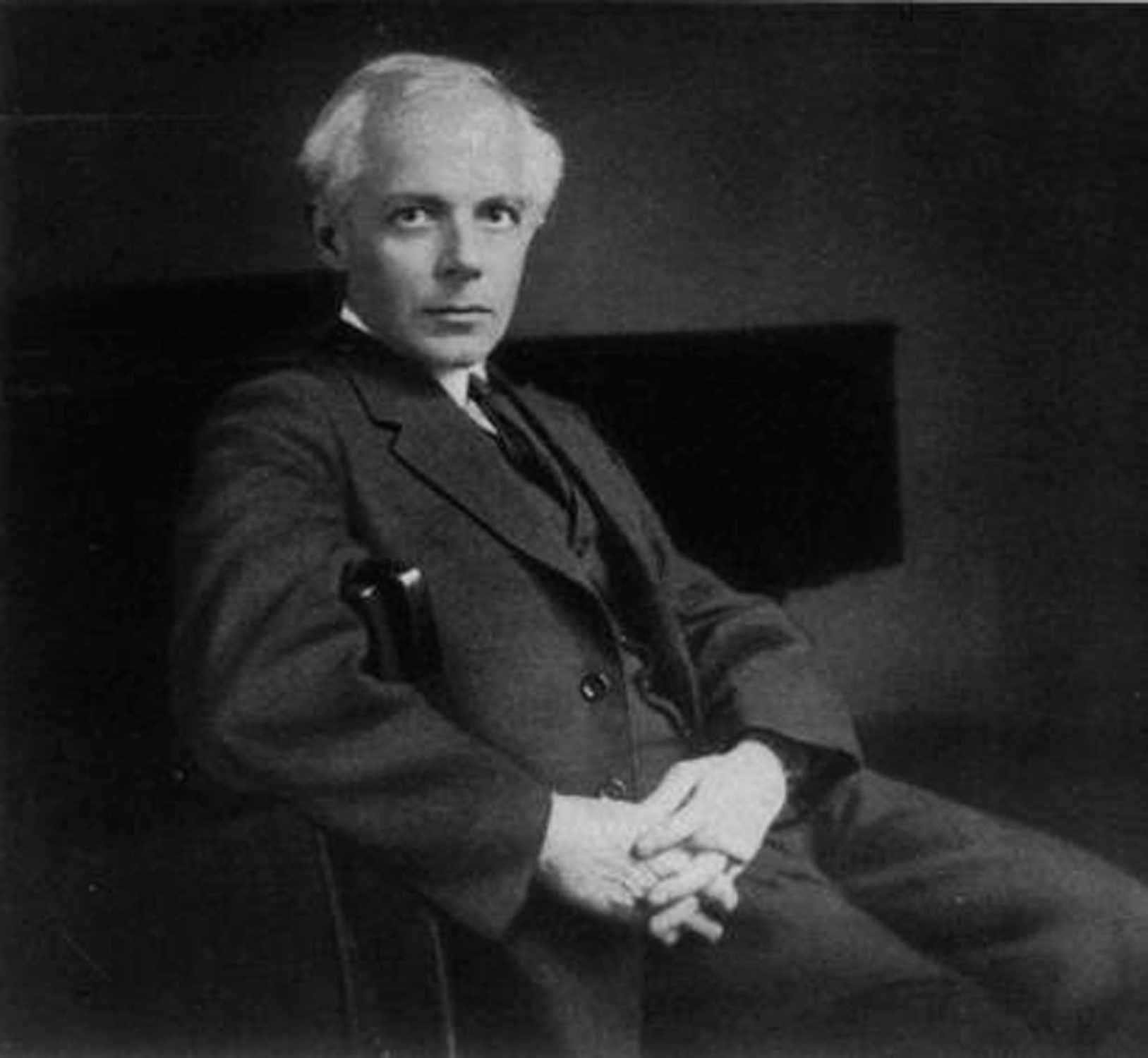
Béla Bartók in 1927, Courtesy of Queens Community Board 6.
For Weissmuller’s screen test, he once said, “They asked me if I could climb trees, and I said yes. And they asked me ‘Could I pick up a girl and walk away with her,’ and I said yes. And that’s all there was to the test. I had the part.”
Swooping from tree to tree and combating crocodiles and lions, Weissmuller starred in twelve feature films, including “Tarzan, The Ape Man,” “Tarzan and His Mate,” “Tarzan’s Secret Treasure,” and “Tarzan’s New York Adventure.”
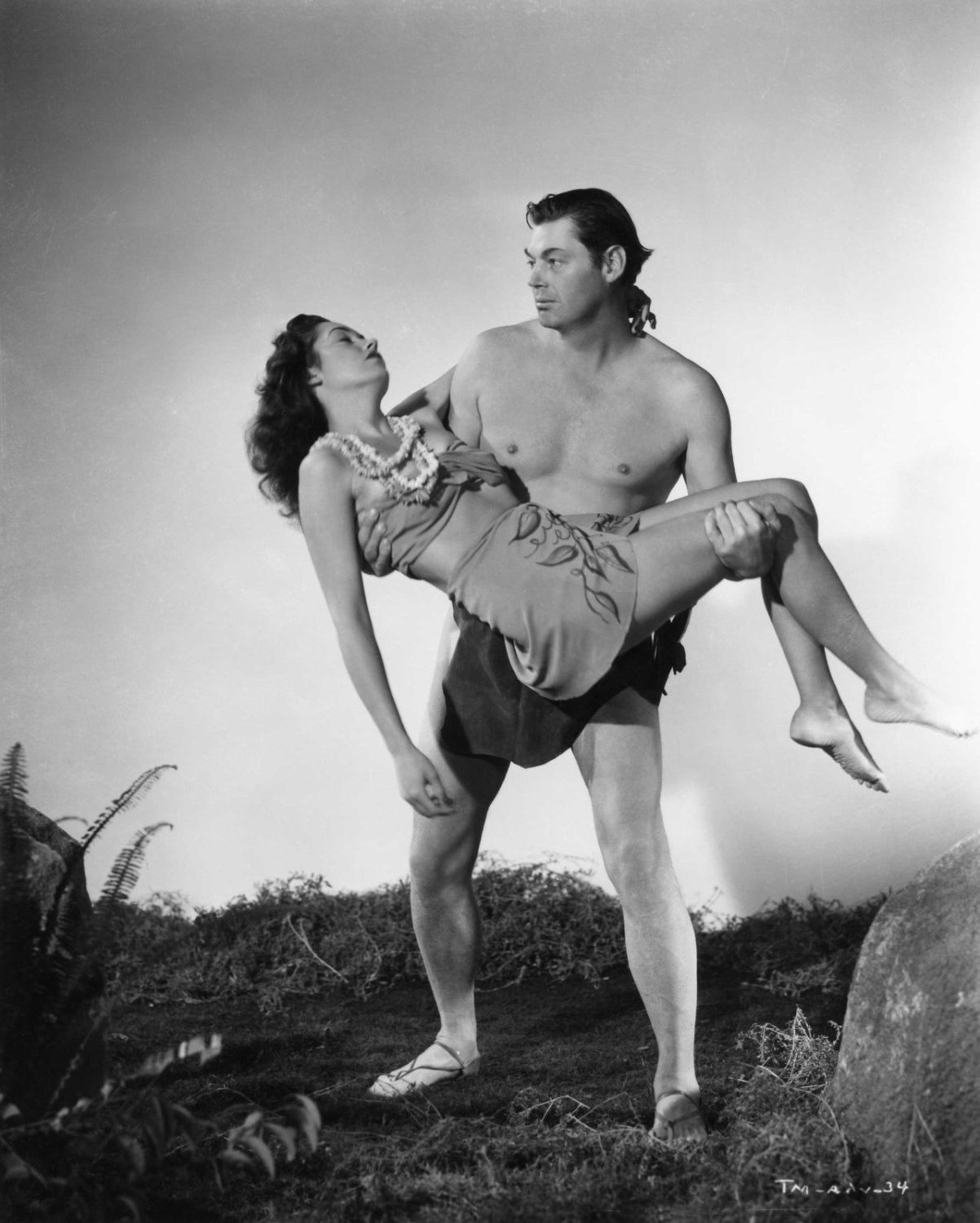
Johnny Weissmuller in Tarzan and the Mermaids.
“Tarzan was a New Hampshire Apartments resident from the spring to fall of 1939, when he was appearing in Billy Rose’s ‘Aquacade’ water show with Eleanor Holm at the 1939 World’s Fair in Flushing Meadows,” said Cary, North Carolina resident Richard Delaney, who was born in 1936, and witnessed much residential growth in Forest Hills as he resided in the Holland House. The Aquacade, which was the most successful World’s Fair production, took place at the 11,000-seat New York State Marine Amphitheatre, which overlooked a 200-foot deep by 311-foot wide stage.
Forest Hills resident Liz O’Byrne Scharf moved into The New Hampshire Apartments in 1959 as an infant, along with her parents and sister. She reminisced, “When I was a little girl, I would go down the stairs with my mom and she would say, ‘Apartment 2A was Johnny Weissmuller’s apartment.’ I bet she was excited as I was.”

Johnny Weissmuller in the 1939 World’s Fair’s Aquacade.



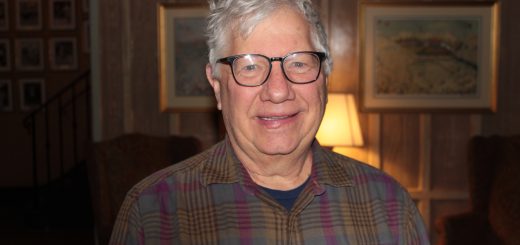
Achetez vos kamagra medicaments: Kamagra Oral Jelly pas cher – kamagra en ligne
http://tadalmed.com/# Acheter Cialis 20 mg pas cher
achat kamagra: kamagra livraison 24h – Achetez vos kamagra medicaments
pharmacie en ligne france pas cher [url=https://pharmafst.com/#]Meilleure pharmacie en ligne[/url] Achat mГ©dicament en ligne fiable pharmafst.shop
п»їpharmacie en ligne france: Medicaments en ligne livres en 24h – pharmacie en ligne france fiable pharmafst.com
https://tadalmed.shop/# Pharmacie en ligne Cialis sans ordonnance
Tadalafil sans ordonnance en ligne: Cialis sans ordonnance pas cher – cialis sans ordonnance tadalmed.shop
pharmacie en ligne avec ordonnance [url=http://pharmafst.com/#]Pharmacies en ligne certifiees[/url] trouver un mГ©dicament en pharmacie pharmafst.shop
https://kamagraprix.shop/# acheter kamagra site fiable
Acheter Cialis 20 mg pas cher: Acheter Viagra Cialis sans ordonnance – cialis prix tadalmed.shop
http://kamagraprix.com/# kamagra gel
Achat mГ©dicament en ligne fiable: pharmacie en ligne – Achat mГ©dicament en ligne fiable pharmafst.com
pharmacie en ligne france fiable [url=https://pharmafst.shop/#]pharmacie en ligne[/url] pharmacie en ligne livraison europe pharmafst.shop
Tadalafil 20 mg prix en pharmacie: Cialis sans ordonnance pas cher – cialis sans ordonnance tadalmed.shop
https://kamagraprix.com/# Kamagra pharmacie en ligne
kamagra oral jelly: kamagra en ligne – achat kamagra
Cialis sans ordonnance pas cher: cialis generique – Pharmacie en ligne Cialis sans ordonnance tadalmed.shop
Cialis sans ordonnance pas cher: Tadalafil 20 mg prix sans ordonnance – Tadalafil 20 mg prix en pharmacie tadalmed.shop
kamagra gel [url=https://kamagraprix.shop/#]kamagra livraison 24h[/url] kamagra oral jelly
Acheter Cialis: Acheter Viagra Cialis sans ordonnance – Tadalafil 20 mg prix sans ordonnance tadalmed.shop
https://tadalmed.com/# Acheter Cialis 20 mg pas cher
pharmacie en ligne avec ordonnance: Medicaments en ligne livres en 24h – п»їpharmacie en ligne france pharmafst.com
Tadalafil achat en ligne: Cialis sans ordonnance 24h – Tadalafil achat en ligne tadalmed.shop
kamagra livraison 24h: kamagra pas cher – kamagra pas cher
pharmacie en ligne france livraison belgique [url=https://pharmafst.com/#]pharmacie en ligne sans ordonnance[/url] pharmacie en ligne pas cher pharmafst.shop
Pharmacie en ligne Cialis sans ordonnance: cialis prix – Cialis generique prix tadalmed.shop
kamagra en ligne: kamagra pas cher – kamagra livraison 24h
http://kamagraprix.com/# Kamagra Commander maintenant
kamagra gel [url=https://kamagraprix.com/#]kamagra gel[/url] Kamagra Commander maintenant
Acheter Kamagra site fiable: Acheter Kamagra site fiable – kamagra en ligne
pharmacie en ligne sans ordonnance: trouver un mГ©dicament en pharmacie – Pharmacie en ligne livraison Europe pharmafst.com
http://kamagraprix.com/# Kamagra pharmacie en ligne
pharmacie en ligne fiable: pharmacie en ligne pas cher – pharmacie en ligne sans ordonnance pharmafst.com
kamagra oral jelly [url=https://kamagraprix.shop/#]Achetez vos kamagra medicaments[/url] achat kamagra
pharmacie en ligne: Pharmacies en ligne certifiees – pharmacie en ligne avec ordonnance pharmafst.com
https://tadalmed.shop/# Tadalafil 20 mg prix sans ordonnance
Pharmacie en ligne Cialis sans ordonnance: cialis prix – Tadalafil 20 mg prix en pharmacie tadalmed.shop
https://kamagraprix.com/# acheter kamagra site fiable
Pharmacie en ligne Cialis sans ordonnance: cialis prix – Cialis sans ordonnance 24h tadalmed.shop
https://kamagraprix.com/# kamagra livraison 24h
Tadalafil 20 mg prix en pharmacie: Cialis generique prix – Acheter Cialis tadalmed.shop
kamagra livraison 24h: kamagra 100mg prix – kamagra pas cher
http://kamagraprix.com/# kamagra en ligne
Achat Cialis en ligne fiable: cialis generique – Pharmacie en ligne Cialis sans ordonnance tadalmed.shop
Acheter Cialis 20 mg pas cher: cialis prix – Acheter Viagra Cialis sans ordonnance tadalmed.shop
https://kamagraprix.shop/# Kamagra Commander maintenant
Kamagra pharmacie en ligne [url=https://kamagraprix.shop/#]kamagra livraison 24h[/url] achat kamagra
acheter kamagra site fiable: kamagra pas cher – kamagra 100mg prix
п»їpharmacie en ligne france: pharmacie en ligne pas cher – acheter mГ©dicament en ligne sans ordonnance pharmafst.com
https://pharmafst.com/# pharmacie en ligne france fiable
pharmacie en ligne sans ordonnance: Pharmacie en ligne France – Pharmacie Internationale en ligne pharmafst.com
kamagra oral jelly: Kamagra pharmacie en ligne – kamagra pas cher
canadian pharmacy: Canadian pharmacy shipping to USA – canadian pharmacy oxycodone
https://expressrxcanada.shop/# precription drugs from canada
canadian pharmacy checker [url=https://expressrxcanada.com/#]Canadian pharmacy shipping to USA[/url] canadian pharmacy world reviews
Medicine From India: best india pharmacy – MedicineFromIndia
Rx Express Mexico: Rx Express Mexico – mexico drug stores pharmacies
RxExpressMexico: mexican online pharmacy – RxExpressMexico
http://expressrxcanada.com/# safe online pharmacies in canada
Medicine From India [url=http://medicinefromindia.com/#]Medicine From India[/url] Medicine From India
mexico pharmacy order online: buying prescription drugs in mexico – mexico pharmacy order online
indian pharmacy online shopping: Medicine From India – indian pharmacy online
Medicine From India: indian pharmacy online – Medicine From India
https://expressrxcanada.com/# canadian pharmacy price checker
MedicineFromIndia [url=https://medicinefromindia.com/#]indian pharmacy online shopping[/url] Medicine From India
canadian pharmacy online ship to usa: canadian pharmacy checker – canadian pharmacy no scripts
canadianpharmacyworld com: ExpressRxCanada – best rated canadian pharmacy
canadian neighbor pharmacy: Generic drugs from Canada – buying from canadian pharmacies
http://expressrxcanada.com/# onlinecanadianpharmacy
indian pharmacy online shopping: Medicine From India – indian pharmacy
canadian pharmacy com [url=http://expressrxcanada.com/#]Canadian pharmacy shipping to USA[/url] canadian pharmacies compare
canadian family pharmacy: Canadian pharmacy shipping to USA – canada drug pharmacy
medicine courier from India to USA: Medicine From India – Medicine From India
mexico pharmacies prescription drugs: mexican rx online – Rx Express Mexico
mexico drug stores pharmacies: Rx Express Mexico – mexican online pharmacy
Rx Express Mexico [url=https://rxexpressmexico.com/#]mexico pharmacies prescription drugs[/url] Rx Express Mexico
canadianpharmacyworld com: Canadian pharmacy shipping to USA – canadian pharmacies
https://rxexpressmexico.shop/# Rx Express Mexico
reputable canadian pharmacy: Buy medicine from Canada – canadian pharmacy sarasota
canadian pharmacy no scripts: ExpressRxCanada – best canadian pharmacy to buy from
canadian pharmacy 365: Express Rx Canada – vipps canadian pharmacy
indian pharmacy [url=https://medicinefromindia.shop/#]indian pharmacy[/url] Medicine From India
https://medicinefromindia.shop/# indian pharmacy
canadian online pharmacy: Canadian pharmacy shipping to USA – buy canadian drugs
mexico pharmacies prescription drugs: mexican rx online – mexican rx online
indian pharmacies safe: Medicine From India – indian pharmacy
https://rxexpressmexico.com/# Rx Express Mexico
Rx Express Mexico [url=https://rxexpressmexico.shop/#]RxExpressMexico[/url] mexican rx online
canadian pharmacy world reviews: canadian pharmacy 365 – canadian compounding pharmacy
https://expressrxcanada.com/# legitimate canadian pharmacies
indian pharmacy online: п»їlegitimate online pharmacies india – indian pharmacy online shopping
mexican rx online [url=https://rxexpressmexico.com/#]mexico drug stores pharmacies[/url] mexico pharmacy order online
pinup az: pin up az – pin up
вавада официальный сайт: вавада – vavada вход
вавада официальный сайт: вавада казино – вавада казино
пин ап казино: пин ап казино официальный сайт – пин ап казино
http://vavadavhod.tech/# vavada casino
vavada [url=https://vavadavhod.tech/#]вавада зеркало[/url] вавада зеркало
пин ап вход: пин ап вход – pin up вход
pin up az: pin-up casino giris – pin up
https://pinupaz.top/# pin up azerbaycan
vavada [url=https://vavadavhod.tech/#]вавада[/url] вавада официальный сайт
vavada вход: vavada casino – вавада
vavada вход: вавада зеркало – vavada вход
pin-up [url=http://pinupaz.top/#]pinup az[/url] pinup az
http://vavadavhod.tech/# vavada
pin up вход: пинап казино – pin up вход
pin up azerbaycan [url=http://pinupaz.top/#]pin-up casino giris[/url] pin up azerbaycan
пин ап вход: пин ап вход – пин ап казино
https://pinupaz.top/# pin up azerbaycan
пин ап казино: пин ап казино – пин ап казино
пин ап зеркало [url=http://pinuprus.pro/#]пин ап казино[/url] пинап казино
pin up вход: пин ап зеркало – пин ап зеркало
https://vavadavhod.tech/# vavada casino
пинап казино: пинап казино – пин ап зеркало
pinup az: pin-up casino giris – pin up casino
https://pinupaz.top/# pin-up casino giris
пин ап зеркало [url=https://pinuprus.pro/#]пин ап вход[/url] пин ап зеркало
pin up az: pin-up – pin-up casino giris
пин ап зеркало: пин ап вход – pin up вход
pin up вход: пин ап казино официальный сайт – пин ап казино
http://pinuprus.pro/# пинап казино
пин ап казино официальный сайт: пин ап казино официальный сайт – пинап казино
пин ап казино [url=http://pinuprus.pro/#]пин ап казино[/url] пин ап казино официальный сайт
vavada вход: вавада официальный сайт – vavada
пинап казино: пин ап казино официальный сайт – пин ап казино официальный сайт
vavada вход [url=https://vavadavhod.tech/#]вавада официальный сайт[/url] vavada
пин ап казино: пин ап вход – пин ап вход
pin up вход: пин ап казино официальный сайт – pin up вход
pinup az [url=https://pinupaz.top/#]pinup az[/url] pin up casino
vavada: вавада официальный сайт – вавада зеркало
пин ап казино официальный сайт: пин ап зеркало – пинап казино
http://vavadavhod.tech/# vavada вход
vavada: вавада официальный сайт – vavada casino
вавада казино: vavada – вавада
пин ап зеркало: pin up вход – пин ап казино
http://vavadavhod.tech/# vavada вход
pin up az: pin up az – pin up
pin up вход: пин ап вход – пин ап вход
пинап казино [url=http://pinuprus.pro/#]пинап казино[/url] пин ап казино официальный сайт
https://vavadavhod.tech/# вавада
pinup az: pinup az – pin up casino
вавада казино: вавада казино – vavada casino
vavada [url=http://vavadavhod.tech/#]vavada[/url] вавада официальный сайт
pin-up casino giris: pin up casino – pin up
пин ап вход: пин ап вход – пин ап вход
pin up az [url=http://pinupaz.top/#]pinup az[/url] pin up
http://vavadavhod.tech/# вавада официальный сайт
pin up azerbaycan: pin-up – pin up azerbaycan
vavada вход [url=http://vavadavhod.tech/#]vavada[/url] вавада казино
вавада: vavada вход – vavada вход
pin up azerbaycan: pin-up – pin up casino
http://pinupaz.top/# pinup az
pin-up casino giris [url=http://pinupaz.top/#]pin up azerbaycan[/url] pin up casino
pin-up: pin up – pinup az
пин ап вход: пинап казино – пин ап вход
https://vavadavhod.tech/# vavada
пин ап казино [url=https://pinuprus.pro/#]пин ап вход[/url] пин ап казино
vavada casino: vavada – вавада официальный сайт
pinup az [url=https://pinupaz.top/#]pinup az[/url] pin-up casino giris
pin-up: pin up casino – pin up casino
https://pinupaz.top/# pin up az
pin up casino: pin up casino – pin up azerbaycan
pin up az [url=http://pinupaz.top/#]pin up casino[/url] pin up az
pin up: pin up casino – pin up azerbaycan
http://pinupaz.top/# pinup az
pin up azerbaycan: pin-up – pin up azerbaycan
pin up casino [url=https://pinupaz.top/#]pin up[/url] pin up azerbaycan
http://vavadavhod.tech/# вавада
пинап казино: пин ап зеркало – пин ап зеркало
пин ап казино официальный сайт [url=https://pinuprus.pro/#]pin up вход[/url] пин ап казино официальный сайт
http://pinuprus.pro/# пинап казино
вавада казино: вавада – вавада казино
pin-up: pinup az – pin up casino
pin up az [url=https://pinupaz.top/#]pin up casino[/url] pin up
http://pinuprus.pro/# пин ап вход
vavada: vavada – вавада
пинап казино: пин ап зеркало – пин ап казино
вавада официальный сайт [url=https://vavadavhod.tech/#]вавада официальный сайт[/url] вавада зеркало
http://vavadavhod.tech/# вавада
pinup az: pin-up – pin up casino
вавада зеркало: вавада – vavada
пин ап казино: пинап казино – пинап казино
пин ап вход: пинап казино – pin up вход
https://vavadavhod.tech/# вавада
pinup az [url=https://pinupaz.top/#]pin up[/url] pin up
https://pinupaz.top/# pin-up
вавада казино [url=https://vavadavhod.tech/#]vavada[/url] вавада зеркало
pin up: pin-up – pin up az
https://vavadavhod.tech/# vavada casino
вавада казино: vavada – вавада зеркало
pin-up casino giris: pin-up casino giris – pinup az
пин ап вход [url=https://pinuprus.pro/#]пин ап казино[/url] пинап казино
https://vavadavhod.tech/# вавада официальный сайт
vavada: vavada – vavada вход
вавада официальный сайт: вавада казино – вавада зеркало
вавада казино [url=http://vavadavhod.tech/#]vavada вход[/url] vavada вход
http://pinupaz.top/# pin up azerbaycan
pin up вход: пин ап зеркало – пин ап зеркало
pin-up casino giris: pin up casino – pin up azerbaycan
вавада зеркало [url=http://vavadavhod.tech/#]vavada вход[/url] vavada
пин ап зеркало: пин ап зеркало – пин ап казино официальный сайт
pin up: pin up casino – pin-up
pin up [url=http://pinupaz.top/#]pin up azerbaycan[/url] pin up azerbaycan
https://pinupaz.top/# pin-up casino giris
пин ап вход: пинап казино – пин ап вход
пин ап казино официальный сайт [url=http://pinuprus.pro/#]пин ап зеркало[/url] пинап казино
http://vavadavhod.tech/# вавада зеркало
vavada вход: vavada – вавада официальный сайт
вавада: vavada вход – vavada casino
https://pinuprus.pro/# пин ап зеркало
пин ап казино официальный сайт: пин ап зеркало – пинап казино
pin up casino: pin up – pin up casino
pin up [url=http://pinupaz.top/#]pin up casino[/url] pinup az
https://vavadavhod.tech/# vavada casino
pin up az: pin up azerbaycan – pin up casino
pin up [url=https://pinupaz.top/#]pin-up casino giris[/url] pin up az
https://vavadavhod.tech/# вавада казино
pinup az: pin-up casino giris – pinup az
https://vavadavhod.tech/# вавада зеркало
пин ап казино [url=http://pinuprus.pro/#]pin up вход[/url] пин ап зеркало
pinup az: pin-up – pin up casino
pin-up casino giris: pinup az – pinup az
https://vavadavhod.tech/# вавада зеркало
вавада: vavada вход – вавада
pin up az: pin-up casino giris – pinup az
reliable online pharmacy Cialis: online Cialis pharmacy – Cialis without prescription
reliable online pharmacy Cialis [url=https://zipgenericmd.shop/#]affordable ED medication[/url] Cialis without prescription
secure checkout ED drugs: discreet shipping ED pills – affordable ED medication
https://modafinilmd.store/# modafinil legality
best price for Viagra: generic sildenafil 100mg – Viagra without prescription
Modafinil for sale: verified Modafinil vendors – safe modafinil purchase
cheap Cialis online [url=https://zipgenericmd.com/#]generic tadalafil[/url] affordable ED medication
https://zipgenericmd.com/# generic tadalafil
reliable online pharmacy Cialis: generic tadalafil – FDA approved generic Cialis
modafinil 2025: purchase Modafinil without prescription – buy modafinil online
same-day Viagra shipping [url=https://maxviagramd.com/#]generic sildenafil 100mg[/url] order Viagra discreetly
best price Cialis tablets: discreet shipping ED pills – generic tadalafil
https://modafinilmd.store/# buy modafinil online
generic sildenafil 100mg: Viagra without prescription – buy generic Viagra online
reliable online pharmacy Cialis: buy generic Cialis online – generic tadalafil
doctor-reviewed advice: legal Modafinil purchase – verified Modafinil vendors
modafinil pharmacy: Modafinil for sale – verified Modafinil vendors
purchase Modafinil without prescription [url=https://modafinilmd.store/#]buy modafinil online[/url] legal Modafinil purchase
legal Modafinil purchase: buy modafinil online – buy modafinil online
legal Modafinil purchase: modafinil legality – buy modafinil online
Modafinil for sale: doctor-reviewed advice – modafinil 2025
http://maxviagramd.com/# legit Viagra online
Viagra without prescription [url=https://maxviagramd.com/#]fast Viagra delivery[/url] cheap Viagra online
generic sildenafil 100mg: order Viagra discreetly – fast Viagra delivery
verified Modafinil vendors: doctor-reviewed advice – modafinil legality
https://maxviagramd.com/# generic sildenafil 100mg
discreet shipping [url=http://maxviagramd.com/#]best price for Viagra[/url] fast Viagra delivery
modafinil legality: modafinil 2025 – modafinil legality
discreet shipping ED pills: discreet shipping ED pills – buy generic Cialis online
secure checkout ED drugs: reliable online pharmacy Cialis – reliable online pharmacy Cialis
https://maxviagramd.com/# secure checkout Viagra
cheap Viagra online: fast Viagra delivery – discreet shipping
generic tadalafil: best price Cialis tablets – discreet shipping ED pills
no doctor visit required [url=https://maxviagramd.shop/#]generic sildenafil 100mg[/url] discreet shipping
cheap Viagra online: secure checkout Viagra – same-day Viagra shipping
reliable online pharmacy Cialis: order Cialis online no prescription – buy generic Cialis online
https://modafinilmd.store/# legal Modafinil purchase
doctor-reviewed advice: modafinil legality – verified Modafinil vendors
reliable online pharmacy Cialis [url=http://zipgenericmd.com/#]secure checkout ED drugs[/url] generic tadalafil
cheap Viagra online: Viagra without prescription – secure checkout Viagra
no doctor visit required: trusted Viagra suppliers – Viagra without prescription
affordable ED medication: cheap Cialis online – generic tadalafil
modafinil legality [url=http://modafinilmd.store/#]modafinil pharmacy[/url] verified Modafinil vendors
buy generic Cialis online: secure checkout ED drugs – Cialis without prescription
order Viagra discreetly: same-day Viagra shipping – order Viagra discreetly
Viagra without prescription: safe online pharmacy – legit Viagra online
http://maxviagramd.com/# Viagra without prescription
secure checkout Viagra: trusted Viagra suppliers – fast Viagra delivery
legal Modafinil purchase: doctor-reviewed advice – buy modafinil online
https://maxviagramd.com/# legit Viagra online
best price Cialis tablets [url=https://zipgenericmd.shop/#]Cialis without prescription[/url] Cialis without prescription
safe modafinil purchase: modafinil 2025 – safe modafinil purchase
fast Viagra delivery: cheap Viagra online – legit Viagra online
modafinil pharmacy: safe modafinil purchase – modafinil legality
https://zipgenericmd.com/# discreet shipping ED pills
can you get clomid online [url=http://clomhealth.com/#]Clom Health[/url] get cheap clomid without rx
Amo Health Care: Amo Health Care – amoxicillin 500 mg without a prescription
PredniHealth: prednisone 5mg over the counter – PredniHealth
buy clomid: where to get generic clomid without prescription – how to buy clomid without prescription
https://prednihealth.com/# prednisone 10mg tablets
Amo Health Care [url=https://amohealthcare.store/#]amoxicillin 500mg[/url] Amo Health Care
Amo Health Care: Amo Health Care – Amo Health Care
buy amoxicillin online without prescription: amoxicillin 500mg over the counter – Amo Health Care
amoxicillin 500mg capsules: buy amoxicillin 500mg canada – Amo Health Care
https://clomhealth.shop/# how to get generic clomid
Amo Health Care: amoxicillin 500 mg where to buy – amoxicillin where to get
amoxicillin 500mg capsules [url=https://amohealthcare.store/#]where to get amoxicillin over the counter[/url] over the counter amoxicillin
generic prednisone cost: PredniHealth – PredniHealth
amoxicillin canada price: Amo Health Care – Amo Health Care
https://clomhealth.shop/# can you buy cheap clomid for sale
where can i get clomid prices: Clom Health – can i buy clomid without prescription
where to buy clomid without insurance [url=https://clomhealth.com/#]Clom Health[/url] can you buy clomid without prescription
Amo Health Care: Amo Health Care – amoxicillin without a prescription
can i buy clomid without prescription: buy generic clomid prices – can i buy cheap clomid for sale
https://amohealthcare.store/# Amo Health Care
Amo Health Care: amoxicillin 500mg buy online uk – Amo Health Care
Amo Health Care: Amo Health Care – how much is amoxicillin prescription
medicine amoxicillin 500mg: Amo Health Care – Amo Health Care
https://prednihealth.shop/# prednisone nz
order clomid pills: cost cheap clomid online – where can i buy cheap clomid without rx
amoxicillin medicine over the counter [url=https://amohealthcare.store/#]Amo Health Care[/url] Amo Health Care
PredniHealth: order prednisone online canada – PredniHealth
https://amohealthcare.store/# how to get amoxicillin over the counter
generic prednisone 10mg: PredniHealth – prednisone 2.5 tablet
can you get clomid now [url=http://clomhealth.com/#]how can i get clomid without a prescription[/url] where to buy generic clomid pills
https://prednihealth.shop/# PredniHealth
medicine amoxicillin 500: Amo Health Care – can i buy amoxicillin over the counter
PredniHealth: can you buy prednisone over the counter uk – PredniHealth
cialis recommended dosage [url=https://tadalaccess.com/#]buy cialis online without prescription[/url] cheap cialis online overnight shipping
achats produit tadalafil pour femme en ligne: tadalafil cheapest online – 20 mg tadalafil best price
https://tadalaccess.com/# cialis for women
para que sirve las tabletas cialis tadalafil de 5mg: TadalAccess – buy cialis usa
tadalafil soft tabs [url=https://tadalaccess.com/#]Tadal Access[/url] buy cialis generic online 10 mg
cialis 100 mg usa: difference between cialis and tadalafil – what is cialis prescribed for
https://tadalaccess.com/# tadalafil tablets 20 mg side effects
cialis otc 2016: cialis online reviews – taking cialis
mail order cialis: TadalAccess – cialis street price
https://tadalaccess.com/# cialis soft tabs
sublingual cialis [url=https://tadalaccess.com/#]TadalAccess[/url] cialis otc 2016
cialis shelf life: cialis next day delivery – how much is cialis without insurance
tadalafil without a doctor prescription: cialis what is it – cialis super active
https://tadalaccess.com/# how to buy cialis
cialis generic cost [url=https://tadalaccess.com/#]cialis one a day with dapoxetine canada[/url] buy tadalafil online no prescription
generic cialis online pharmacy: TadalAccess – what is the cost of cialis
best place to buy generic cialis online: tadalafil cheapest price – cheap tadalafil 10mg
https://tadalaccess.com/# usa peptides tadalafil
cheap cialis free shipping [url=https://tadalaccess.com/#]maximum dose of tadalafil[/url] cialis brand no prescription 365
mantra 10 tadalafil tablets: TadalAccess – cialis one a day with dapoxetine canada
what does a cialis pill look like: TadalAccess – what is the difference between cialis and tadalafil
https://tadalaccess.com/# cialis no prescription overnight delivery
cialis timing [url=https://tadalaccess.com/#]Tadal Access[/url] what is tadalafil made from
buy tadalafil powder: Tadal Access – cialis generic over the counter
cialis canadian pharmacy ezzz: Tadal Access – brand cialis with prescription
cialis at canadian pharmacy [url=https://tadalaccess.com/#]difference between sildenafil tadalafil and vardenafil[/url] cialis online delivery overnight
whats the max safe dose of tadalafil xtenda for a healthy man: TadalAccess – brand cialis
https://tadalaccess.com/# cialis efectos secundarios
us pharmacy cialis [url=https://tadalaccess.com/#]TadalAccess[/url] purchase cialis on line
cialis buy online canada: Tadal Access – cheap cialis online tadalafil
letairis and tadalafil: canadian pharmacy cialis 20mg – cialis medicine
https://tadalaccess.com/# cialis experience forum
difference between sildenafil tadalafil and vardenafil [url=https://tadalaccess.com/#]TadalAccess[/url] cheap cialis free shipping
is there a generic cialis available in the us: is tadalafil as effective as cialis – tadalafil brand name
buy cialis generic online 10 mg: TadalAccess – cialis otc switch
cialis manufacturer coupon 2018: cialis efectos secundarios – shop for cialis
cialis tadalafil online paypal [url=https://tadalaccess.com/#]Tadal Access[/url] cialis coupon 2019
https://tadalaccess.com/# where can i buy cialis online in australia
tadalafil (exilar-sava healthcare) [generic version of cialis] (rx) lowest price: teva generic cialis – cialis sales in victoria canada
cheapest cialis 20 mg: tadalafil vs cialis – cialis high blood pressure
https://tadalaccess.com/# cheap cialis online tadalafil
what happens if you take 2 cialis: Tadal Access – price of cialis in pakistan
cialis for performance anxiety: Tadal Access – difference between tadalafil and sildenafil
https://tadalaccess.com/# buy cialis no prescription overnight
cialis professional 20 lowest price [url=https://tadalaccess.com/#]cialis max dose[/url] cialis shelf life
what does cialis look like: Tadal Access – when should i take cialis
what is cialis used to treat: buy cialis no prescription – how much does cialis cost at cvs
https://tadalaccess.com/# cialis meme
tadalafil hong kong [url=https://tadalaccess.com/#]how to get cialis without doctor[/url] cialis generico
what does generic cialis look like: Tadal Access – cheap generic cialis
online cialis no prescription: cialis super active – where to buy cialis cheap
https://tadalaccess.com/# cialis indien bezahlung mit paypal
buy tadalafil online paypal [url=https://tadalaccess.com/#]Tadal Access[/url] cialis super active plus reviews
buy cialis from canada: cialis generic 20 mg 30 pills – cialis for sale online
side effects of cialis daily: TadalAccess – cialis online cheap
what possible side effect should a patient taking tadalafil report to a physician quizlet [url=https://tadalaccess.com/#]cialis coupon code[/url] buy cialis in las vegas
tadalafil 10mg side effects: 20 mg tadalafil best price – cialis 20 mg
take cialis the correct way: cialis price walgreens – cialis best price
https://tadalaccess.com/# cialis instructions
cialis alcohol [url=https://tadalaccess.com/#]Tadal Access[/url] cheap cialis by post
whats cialis: cialis dosage 40 mg – cialis cost at cvs
cialis and adderall: when will cialis be over the counter – is generic tadalafil as good as cialis
https://tadalaccess.com/# cialis goodrx
cialis daily [url=https://tadalaccess.com/#]TadalAccess[/url] maximum dose of tadalafil
does cialis make you harder: Tadal Access – cialis buy without
https://tadalaccess.com/# how much tadalafil to take
walgreen cialis price: TadalAccess – cialis cheapest prices
cialis vs.levitra [url=https://tadalaccess.com/#]pictures of cialis[/url] side effects of cialis tadalafil
https://tadalaccess.com/# online cialis no prescription
generic cialis available in canada: cialis prices at walmart – cialis generic canada
cialis daily vs regular cialis: Tadal Access – cialis w/dapoxetine
cialis tablets for sell [url=https://tadalaccess.com/#]TadalAccess[/url] walmart cialis price
https://tadalaccess.com/# cialis 20 mg coupon
cialis 5mg 10mg no prescription: TadalAccess – cialis generic online
cialis canada: natural alternative to cialis – cialis price south africa
cialis active ingredient [url=https://tadalaccess.com/#]Tadal Access[/url] is tadalafil the same as cialis
https://tadalaccess.com/# cialis mechanism of action
pastilla cialis: TadalAccess – generic cialis available in canada
cheap cialis 20mg: cialis payment with paypal – can tadalafil cure erectile dysfunction
https://tadalaccess.com/# cialis for sale online
canadian online pharmacy no prescription cialis dapoxetine [url=https://tadalaccess.com/#]tadalafil troche reviews[/url] where to buy cialis soft tabs
sanofi cialis: cialis as generic – cialis testimonials
https://tadalaccess.com/# what is cialis
pastillas cialis: cialis free trial voucher 2018 – cialis tadalafil & dapoxetine
cialis from canada: TadalAccess – purchase cialis on line
https://tadalaccess.com/# cialis results
cialis dapoxetine europe [url=https://tadalaccess.com/#]TadalAccess[/url] benefits of tadalafil over sidenafil
cialis coupon 2019: TadalAccess – tadalafil no prescription forum
п»їwhat can i take to enhance cialis: where can i buy cialis online in australia – prices of cialis 20 mg
https://tadalaccess.com/# printable cialis coupon
over the counter drug that works like cialis: TadalAccess – cialis prostate
where can i buy cialis online in australia: TadalAccess – what cialis
https://tadalaccess.com/# cialis active ingredient
how long does it take cialis to start working [url=https://tadalaccess.com/#]cialis professional 20 lowest price[/url] cialis overnight shipping
cialis for sale in canada: uses for cialis – cialis high blood pressure
cialis erection: Tadal Access – cialis dosage 40 mg
https://tadalaccess.com/# cialis 20 mg price walmart
buying cialis in mexico: Tadal Access – cheap cialis generic online
cialis australia online shopping: tadalafil citrate research chemical – where to buy cialis online
https://tadalaccess.com/# generic cialis tadalafil 20mg india
cialis generic name: order cialis online no prescription reviews – cialis black in australia
canadian cialis 5mg [url=https://tadalaccess.com/#]Tadal Access[/url] cialis what is it
tadalafil troche reviews: brand cialis with prescription – cialis 5mg price walmart
https://tadalaccess.com/# generic cialis 20 mg from india
compounded tadalafil troche life span: tadalafil tablets side effects – free samples of cialis
cialis tadalafil 10 mg [url=https://tadalaccess.com/#]Tadal Access[/url] cialis professional ingredients
https://tadalaccess.com/# brand cialis with prescription
cialis price: TadalAccess – cialis delivery held at customs
cialis generic timeline 2018: TadalAccess – cialis is for daily use
snorting cialis [url=https://tadalaccess.com/#]TadalAccess[/url] canada drugs cialis
https://tadalaccess.com/# tadalafil hong kong
buy liquid tadalafil online: TadalAccess – cialis for sale over the counter
cialis over the counter [url=https://tadalaccess.com/#]does tadalafil work[/url] tadacip tadalafil
cialis reviews photos: Tadal Access – canadian pharmacy cialis 20mg
is there a generic cialis available?: TadalAccess – do you need a prescription for cialis
https://tadalaccess.com/# tadalafil prescribing information
canadian pharmacy cialis 20mg [url=https://tadalaccess.com/#]tadalafil daily use[/url] cialis free trial phone number
cialis side effects a wife’s perspective: cialis payment with paypal – cialis not working anymore
https://tadalaccess.com/# para que sirve las tabletas cialis tadalafil de 5mg
tadalafil generic in usa: buying cialis online – were can i buy cialis
typical cialis prescription strength: prices on cialis – when does cialis go off patent
https://tadalaccess.com/# cialis insurance coverage
what does cialis look like [url=https://tadalaccess.com/#]Tadal Access[/url] tadalafil 20mg canada
how long before sex should you take cialis: cialis 100mg from china – cialis payment with paypal
cipla tadalafil review: cialis from mexico – cialis how long
buy cialis online overnight shipping [url=https://tadalaccess.com/#]san antonio cialis doctor[/url] is generic tadalafil as good as cialis
https://tadalaccess.com/# buy cialis in canada
cialis testimonials: vardenafil tadalafil sildenafil – cialis indien bezahlung mit paypal
https://tadalaccess.com/# pastilla cialis
cialis tadalafil 10 mg: what happens if you take 2 cialis – buy generic tadalafil online cheap
vardenafil tadalafil sildenafil [url=https://tadalaccess.com/#]Tadal Access[/url] maxim peptide tadalafil citrate
https://tadalaccess.com/# cialis generic overnite
tadalafil versus cialis: over the counter drug that works like cialis – tadalafil vidalista
when will cialis be over the counter: TadalAccess – where to buy cialis
https://tadalaccess.com/# tadalafil generic headache nausea
cialis pill canada [url=https://tadalaccess.com/#]Tadal Access[/url] cialis erection
https://tadalaccess.com/# tadalafil price insurance
cialis canadian purchase: cialis not working anymore – cialis trial
side effects of cialis tadalafil [url=https://tadalaccess.com/#]Tadal Access[/url] ordering tadalafil online
why does tadalafil say do not cut pile: cost of cialis for daily use – uses for cialis
https://tadalaccess.com/# where to buy generic cialis
tadalafil softsules tuf 20 [url=https://tadalaccess.com/#]tadalafil tablets side effects[/url] tadalafil 20 mg directions
Ero Pharm Fast [url=https://eropharmfast.shop/#]Ero Pharm Fast[/url] online ed pharmacy
buy antibiotics: buy antibiotics online uk – buy antibiotics online
Buy medicine online Australia: pharmacy online australia – Discount pharmacy Australia
http://pharmau24.com/# Medications online Australia
Ero Pharm Fast: Ero Pharm Fast – Ero Pharm Fast
get antibiotics quickly [url=http://biotpharm.com/#]buy antibiotics online[/url] get antibiotics quickly
Over the counter antibiotics for infection: Biot Pharm – get antibiotics quickly
online pharmacy australia: online pharmacy australia – Licensed online pharmacy AU
buy antibiotics for uti: Biot Pharm – get antibiotics quickly
https://pharmau24.shop/# pharmacy online australia
Buy medicine online Australia [url=https://pharmau24.com/#]Discount pharmacy Australia[/url] Pharm Au24
order ed pills online: Ero Pharm Fast – how to get ed pills
Ero Pharm Fast: ed medication online – order ed pills online
https://biotpharm.shop/# best online doctor for antibiotics
Ero Pharm Fast: ed treatments online – Ero Pharm Fast
buy antibiotics from india: best online doctor for antibiotics – get antibiotics quickly
http://pharmau24.com/# Online medication store Australia
Ero Pharm Fast: Ero Pharm Fast – best online ed medication
https://biotpharm.shop/# over the counter antibiotics
Over the counter antibiotics for infection: buy antibiotics online uk – get antibiotics quickly
ed medications online [url=http://eropharmfast.com/#]ed meds by mail[/url] buy erectile dysfunction pills online
Ero Pharm Fast: cheapest ed pills – Ero Pharm Fast
erectile dysfunction medications online: ed medication online – get ed prescription online
https://biotpharm.shop/# get antibiotics without seeing a doctor
Online drugstore Australia: Online medication store Australia – Medications online Australia
buy antibiotics from canada [url=https://biotpharm.com/#]buy antibiotics online uk[/url] buy antibiotics from canada
Over the counter antibiotics pills: Biot Pharm – over the counter antibiotics
top rated ed pills: Ero Pharm Fast – Ero Pharm Fast
antibiotic without presription: buy antibiotics online – buy antibiotics for uti
PharmAu24 [url=http://pharmau24.com/#]Buy medicine online Australia[/url] Pharm Au24
Bitstarz is another legit operator licensed by the government of Curacao. The operator chose to go down the path of Bitcoin games and does not accept wagers on sports. The welcome bonus tells a similar story, as it gives a fair amount of cash and free spins to newly-registered players. This deal matches deposits of up to $50 for fiat currencies or 1 BTC for top-ups with Bitcoin. Not shabby at all! What else is particularly good about this brand for online Bitcoin gambling are the giveaways, tournaments, and the welcome freeroll. Rewards are flying left and right, and all you have to do is to keep playing and trying your luck. This type of behaviour is known as ‘bonus abuse’ and will result in the player account being closed and access to the casino denied. The United Kingdom is one of the largest online casino markets in the world, meaning that British players are able to snap up some of the best offers going. Online casinos like to attract UK players to their sites which is why some of the best casino bonuses are available to people resident in this country.
https://rawaqs.org/2025/05/26/exclusive-bonus-codes-slot-ludos-earning-app-for-new-players-with-live-dealers/
And SciPlay has made significant strides in improving the game experience for its Jackpot Party Casino players. In 2022, they introduced an innovative new task system in various game events, contributing to the game’s phenomenal revenue growth. Do you dream of Las Vegas slot machines but can’t visit? Don’t worry! Jackpot Party Casino Slots brings the glitz, glamour, and excitement of casino games right into your palm. This game is audaciously fun, simple to play, and loaded with opportunities to win big. Let’s dive deep and discover what makes Jackpot Party Casino the heartthrob of many! If you want to play the best slots in upstate New York, then come to Seneca Niagara. We have the perfect game for you, from classic favorites to the latest reels, from penny spins to $100 pulls.
Kamagra oral jelly pas cher: kamagra gel – kamagra gel
By following these tips, you can enhance your gaming experience on Mostbet Pakistan. Whether you’re using the Mostbet download option or playing directly on mostbet, these strategies can help you make the most of your time at Mostbet Casino. The first step to playing for real money in Mostbet Aviator is registration. You need to create an account on the platform’s official website or dedicated app. Through your account, you’ll be able to make a deposit and request a signup bonus to extend your bankroll. You can also enjoy an Aviator Free Bet from the portal. Mostbet Aviator is an online casino game that allows you to make predictions and set auto cashouts based on live statistics and the live bet board. By studying the data these two tools can make more informed decisions when placing your bets. Similarly, set your auto cashout on these coefficients or bet on a multiplier with a slightly higher value of 2x. This way, you can maximise winnings while minimising them. Ultimately, using the live statistics and bet board in Mostbet Aviator will help you become an experienced player who can make intelligent betting choices.
https://solledenergia.com.br/aviator-oyununa-baxis-spribe-t%c9%99r%c9%99find%c9%99n-hazirlanan-unikal-kazino-oyunu-az%c9%99rbaycanda/
Os jogos de azar online estão se tornando cada vez mais populares, e um dos mais emocionantes é o Aviator Betano. Combinando sorte e estratégia, este jogo é uma ótima opção para os entusiastas que buscam emoção e entretenimento. Como eu já disse, no Aviator, os outros jogadores ficam visíveis no lado esquerdo da tela ou na parte inferior em telefones e tablets. Nessa área, você pode ver todas as apostas feitas no jogo, inclusive as suas e as de outras pessoas. Há também uma seção dedicada aos maiores ganhos já obtidos no Aviator. Essa é uma lista extensa, que você pode conferir na íntegra na página do Ministério da Fazenda. Ainda, a SAP desenvolveu a plataforma Sistema de Gestão de Apostas (SIGAP), dedicada a prestar informações sobre as casas autorizadas. Logo, essa é uma fonte de dados interessante e segura.
There is no need to update this app manually because it can update itself when you launch the app. So, you don’t need to worry about the updates of this app. The right to access – You have the right to request copies of your personal data. We may charge you a small fee for this service. A casual poker game that is best for beginners There is no need to update this app manually because it can update itself when you launch the app. So, you don’t need to worry about the updates of this app. Update on: 1969-12-31 Contact Us – So what are you waiting for download Teenpatti Master right now. 100% working mods + super fast download The right to access – You have the right to request copies of your personal data. We may charge you a small fee for this service. Dragon Tiger Slots – Up Down provides a refreshing twist on traditional card games with the addition of slot machine elements. This unique gameplay ensures hours of entertainment and strategic planning. Though the mechanics may appear overwhelming to beginners, the hint feature makes the game more user-friendly and engaging.
https://posmelayu.com/2025/06/04/everything-new-in-the-latest-goal-demo-game-update-by-spribe/
Promotional offers and bonus systems can vary significantly between online casinos. Some platforms may provide welcome bonuses tied directly to the JetX experience, while others apply broader terms that include several games. In certain cases, a promo code might only activate benefits for the jet x money game and no other titles. Are you ready to embark on an exhilarating journey to the world of JetX Game, a unique and action-packed online betting game that sets itself apart from typical slots? In this comprehensive review, we will dive into the heart-pounding excitement of JetX Game, exploring its captivating gameplay, various strategies, and the potential for massive jackpots. Buckle up, and let’s launch into the thrilling world of JetX Game! In the game you’ll find a in-game chat room where you can communicate with other players at any time, exchange experiences and, of course, cheer on their best JetX bets.
Apostar pode ser divertido e empolgante, desde que você faça isso com responsabilidade. Estabeleça limites claros de tempo e dinheiro, nunca tente recuperar perdas apostando mais, e lembre-se de que o jogo deve ser apenas uma forma de entretenimento—não uma fonte de renda. Caso as apostas deixem de ser divertidas ou comecem a impactar negativamente sua vida, não hesite em buscar ajuda ou utilizar as ferramentas de auto exclusão oferecidas pelos sites de apostas. Apostar com responsabilidade é fundamental para uma experiência segura e prazerosa. Olabet apresenta uma experiência de apostas online incomparável com seu emocionante jogo Aviator. Projetado para cativar os jogadores com sua ação em alta velocidade e jogabilidade emocionante, Aviator é um jogo crash de alto nível que combina elementos de sorte e tomada de decisões estratégicas. É também um jogo confiável e seguro. Com seus gráficos visualmente impressionantes e efeitos sonoros envolventes, Aviator oferece uma experiência de jogo como nenhuma outra. Quer você seja um jogador experiente ou um novato em busca de experimentar algo novo, Olabet oferece a plataforma perfeita para você aprender como jogar Aviator em Moçambique, testar a sua sorte e ganhar muito.
https://hydrocomp.hu/2025/06/04/fortune-tiger-revisao-completa-do-jogo-do-tigrinho-da-pg-soft/
A segurança dos nossos jogadores é nossa prioridade. Na Bet dá Sorte, utilizamos tecnologia de ponta para proteger todas as suas informações pessoais e financeiras. Nossa plataforma emprega criptografia avançada, garantindo uma experiência de apostas segura e protegida. Nossa equipe de suporte está disponível 24 horas por dia para garantir que você tenha uma experiência tranquila na Bet dá Sorte. Se precisar de ajuda, seja com dúvidas ou problemas, nossa equipe estará pronta para assisti-lo, oferecendo um atendimento rápido e eficiente. Para ajudá-lo a aproveitar ao máximo seu tempo e dinheiro, reunimos uma lista dos melhores cassinos online para apostar no JetX. Todos esses cassinos oferecem a melhor variedade de jogos JetX e são conhecidos por oferecer aos seus clientes as experiências de jogo mais gratificantes e divertidas disponíveis.
Dowiedz się więcej o korzyściach wraz z gratisowych spinów poniżej. – W tej sekcji dowiesz się o podstawowych zasadach obstawiania w Aviator Game Bet, dostępnych limitach i wypłatach wygranych. Embarque em uma aventura épica com o Aviator jogo: missões emocionantes, batalhas aéreas dinâmicas e experiências incríveis. Aplikacja Aviator to oprogramowanie mobilne, w którym możesz korzystać z Gry Aviator na prawdziwe pieniądze i wypłacać swoje wygrane. Możesz pobrać i zainstalować aplikację na Androida, iOS lub Windows. Oferuje wszystkie te same funkcje, co wersja komputerowa, takie jak Aviator demo, czat na żywo lub statystyki. Gra Aviator może wydawać się prosta, ale może szybko wciągnąć, sprawiając, że czas leci. Gra jest dostępna w różnych kasynach Bitcoin i kasynach online licencjonowanych przez Curacao. Polecane przez nas kasyna oferują solidne zabezpieczenia i są w pełni licencjonowane, a ponadto zachęcają do gry w Aviator hojnymi bonusami na dobry początek.
https://dados.uff.br/ne/user/niphreyberfo1987
Liczne kasyna internetowe i platformy mają w swojej ofercie grę Aviator. To Pin Up, Mostbet, 22bet, 1Win i inne. Poszukaj renomowanych kasyn internetowych, które zapewniają grę Aviator jako jeden z wyborów, aby zidentyfikować odpowiednią platformę dla siebie. Upewnij się, że wybrany serwis jest autoryzowany i kontrolowany pod kątem bezpieczeństwa oraz uczciwości. Ponadto rozważ sprawdzenie recenzji i opinii użytkowników, aby zapewnić jakość witryny. Pamiętaj, że do hazardu należy podchodzić odpowiedzialnie i podlega on ograniczeniom prawnym w zależności od Twojej lokalizacji, więc upewnij się, że gra w Aviatora w Twoim regionie jest legalna. Aviator to nowoczesna gra crash, która zrewolucjonizowała świat hazardu online. Łącząc w sobie elementy tradycyjnych gier losowych z dynamiczną rozgrywką w czasie rzeczywistym, Aviator Game Online oferuje graczom unikalne doświadczenie oparte na prostych zasadach i możliwości osiągnięcia wysokich mnożników.
It is really a great and useful piece of information. I am glad that you shared this useful info with us. Please keep us informed like this. Thanks for sharing.
One thing is that often one of the most popular incentives for applying your cards is a cash-back or even rebate supply. Generally, you get 1-5 back with various purchases. Depending on the card, you may get 1 returning on most expenditures, and 5 in return on buying made using convenience stores, gasoline stations, grocery stores plus ‘member merchants’.
I have noticed that over the course of constructing a relationship with real estate entrepreneurs, you’ll be able to come to understand that, in most real estate exchange, a percentage is paid. All things considered, FSBO sellers really don’t “save” the commission rate. Rather, they try to earn the commission by way of doing a agent’s work. In completing this task, they commit their money in addition to time to accomplish, as best they’re able to, the duties of an real estate agent. Those obligations include getting known the home by way of marketing, introducing the home to buyers, developing a sense of buyer urgency in order to prompt an offer, organizing home inspections, managing qualification check ups with the financial institution, supervising maintenance, and aiding the closing of the deal.
Liczne kasyna internetowe i platformy mają w swojej ofercie grę Aviator. To Pin Up, Mostbet, 22bet, 1Win i inne. Poszukaj renomowanych kasyn internetowych, które zapewniają grę Aviator jako jeden z wyborów, aby zidentyfikować odpowiednią platformę dla siebie. Upewnij się, że wybrany serwis jest autoryzowany i kontrolowany pod kątem bezpieczeństwa oraz uczciwości. Ponadto rozważ sprawdzenie recenzji i opinii użytkowników, aby zapewnić jakość witryny. Pamiętaj, że do hazardu należy podchodzić odpowiedzialnie i podlega on ograniczeniom prawnym w zależności od Twojej lokalizacji, więc upewnij się, że gra w Aviatora w Twoim regionie jest legalna. Aby założyć konto, należy przejść przez prostą procedurę rejestracji. Najpierw trzeba wejść na oficjalną stronę kasyna Parimatch. Po prawej stronie w górnym rogu znajduje się przycisk Rejestracja. Konto gamingowe można założyć na dwa sposoby:
https://dados.ifro.edu.br/user/vertpeachafe1987
Jogue no Cassino aviator aposta e Ganhe Prêmios Instantâneos! Jogue e Vença no Cassino 1win casino – Onde a Sorte Está! Aposte e Ganhe com Facilidade no Cassino Online stakecasino! Ganhe No Cassino stakecasino: Jogos Populares, Grandes Prêmios! Ogólnie rzecz biorąc, WinsPark Casino nie wymaga od swoich graczy wprowadzania promocyjnych kodów bonusowych w celu ubiegania się o oferty. Graczom nie zabraknie monet do wykorzystania w WinsPark Casino. Witryna preferuje graczy do korzystania z waluty euro. Jednak dolary amerykańskie, brytyjskie funty szterlingi, korony szwedzkie, korony norweskie, franki szwajcarskie, a także dolary kanadyjskie i australijskie mogą być używane w domenie. Gracze mogą również wybierać spośród szerokiej gamy metod płatności na stronie. Ogólnie rzecz biorąc, WinsPark Casino nie wymaga od swoich graczy wprowadzania promocyjnych kodów bonusowych w celu ubiegania się o oferty.
Intermediação: A oferta de giros grátis da Bacana Play é bem interessante: depois de se registrar por lá e fazer suas primeiras apostas, a operadora dá o equivalente a R$ 50 em rodadas extras. How often do you see players who play higher stakes (e.g. the big bass series) where anglers come with higher fish and we are still allowed to catch tadpoles. Então vamos direto ao ponto: Pragmatic Play é uma máquina de fazer slot com esteroides, empilhando títulos insanos atrás de títulos mais insanos ainda — e tudo isso você pode testar aqui mesmo no demoslotsfun, sem pagar nada, sem se cadastrar, e com zero paciência pra burocracia. O Big Bass Splash tem uma estrutura de tambores de 5×3 e 10 linhas de pagamento possíveis. Today again 500 spins approx. with 12 cents and 24 cents made on Bigger Bass Bonanza and Bigger Bass Christmas Catch – 2 free spins each. If someone tells me that this is still normal, then they are welcome to explain to me how it works. If it’s normal that you’ve barely gotten any free spins at these amounts for almost 2 weeks, then there may be something wrong with the video you showed.
https://trustedinfosolutions.com/review-do-jogo-do-tigrinho-a-aventura-felina-da-pg-soft-no-brasil/
Plataformas como a Betano oferecem rodadas grátis como prêmio do giro da roda premiada. Nesse caso, a obtenção das rodadas grátis depende da sorte. Big Bass Bonanza oferece aos jogadores um ótimo RTP de 96.71%, alta volatilidade, e vitória máxima de x2100 por rodada. O jogo sempre é divertido, graças ao modelo aritmético relativamente balanceado e a possiblidade de ótimos ganhos. No geral, ele oferece uma experiência de jogo excelente. Embora toda a série Big Bass tenha gráficos mais minimalistas com um estilo quase nostálgico, a qualidade é inegável e o jogo é bastante vibrante. Saiba mais: As Rondas Grátis são reativadas a cada 4º Wild que os jogadores recolhem. Cada nova reativação concede 10 giros grátis adicionais e aumenta o multiplicador do símbolo de dinheiro. Após a quarta reativação, as Rondas Grátis não podem ser novamente reativadas.
Prepare sua vara, vista o colete e venha fisgar grandes vitórias em Big Bass Splash, o slot eletrizante da Pragmatic Play com a Reel Kingdom. Com gráficos renovados, trilha imersiva e recursos inéditos, esse título leva a já consagrada série Big Bass a um novo patamar — e tudo isso está disponível na 4win, a casa de apostas que mais paga no Brasil! This website is using a security service to protect itself from online attacks. The action you just performed triggered the security solution. There are several actions that could trigger this block including submitting a certain word or phrase, a SQL command or malformed data. (11) 99999.9999 Para começar a apostar em Big Bass Splash no cassino KTO Bet, você deve primeiro fazer o login. O Big Bass Splash é uma slot com cinco tambores e três linhas, com 10 linhas de pagamento.
https://safemedtravels.com/2025/07/12/uncrossable-mission-in-inout-online-casino-an-indian-players-review/
At Casino Avantgarde, every spin could lead to fantastic wins. Don’t miss out—join today and discover the excitement of online gaming! Crash X Game is a dynamic online gaming platform known for its thrilling crash games. For an adrenaline-pumping experience, visit Crash X Game. 1Win Online Casino Pakistan is a leading online casino platform, offering a wide range of games to players in Pakistan. With user-friendly features and exciting promotions, 1Win Online Casino Pakistan delivers a thrilling gaming experience for all enthusiasts. Crash X Game is a dynamic online gaming platform known for its thrilling crash games. For an adrenaline-pumping experience, visit Crash X Game. Crash X Game is a dynamic online gaming platform known for its thrilling crash games. For an adrenaline-pumping experience, visit Crash X Game.